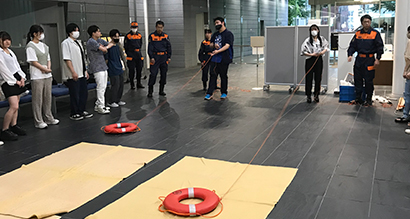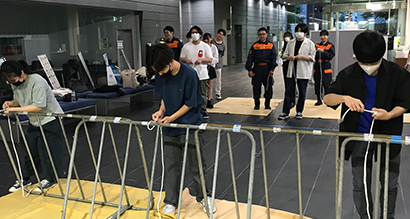JIU Josai International University

Kojimachi Police Station teaches students disaster prevention knowledge 14 members of Kioicho University Festival Executive Committee participate
student activities
2023.07.06

A police officer from Koji-machi explains about the major disasters that have occurred in Japan and overseas using photo panels.

Students trying out how to tie a rope

Practice making an emergency stretcher out of a blanket and transporting it

Assuming water rescue, learn how to throw a float
Members of the Kojimachi Police Station (Chiyoda Ward, Tokyo) Security Section visited the Tokyo Kioicho Campus on June 29th and taught the students disaster prevention knowledge and techniques. The police station is developing educational activities to raise knowledge about disaster prevention at universities in the ward, and this time was also held as part of that. 14 members of the "Kioicho University Festival Executive Committee", which is active as an official organization of the campus, participated in the event and learned how to tie ropes and make a stretcher from blankets in preparation for an emergency that could occur anywhere at any time. .
After receiving explanations from police officers about what happened at the site of the Great East Japan Earthquake and other major disasters overseas, using photographs, and what was needed for rescue, the students began practical training. Ta. The first is how to tie the rope. Lectures are given on how to tie a knot, which is often used at disaster sites, and how to tie a knot, which can be easily tied to a stick, because it can be tied quickly and is difficult to untie even if pulled, and at the same time it is easy to untie with your fingers. After receiving the invitation, the students tried tying the knot one by one on the spot, and it seemed that they learned how to do it immediately.
They also learned how to carry the injured or sick on a stretcher that uses a blanket rolled up many times as a pole, and how to throw a float used for water rescue. Finally, assuming a tense scene where every second counts for every minute at an actual disaster site, participants were divided into three teams and practiced what they had learned that day, and competed for time in a game format.
Ms. Sayaka Yoshino (3rd year Faculty of Media Studies), the representative of the participating committee, said, "It was a very valuable experience, as I was able to acquire skills that I would not have been able to learn otherwise, such as how to tie a rope." I was talking to In addition, Koji Ide (2nd year Faculty of Media Studies) commented, "I was able to learn not only useful knowledge in case of emergency, but also techniques that I can use in my daily life."
In order to continue disaster prevention education at our university, we are planning to have people from the Kojimachi police station visit us again in July and give lectures for other authorized organizations.

Compete for the time to execute disaster prevention "techniques" in a game format

Commemorative photo with the police officers who guided us